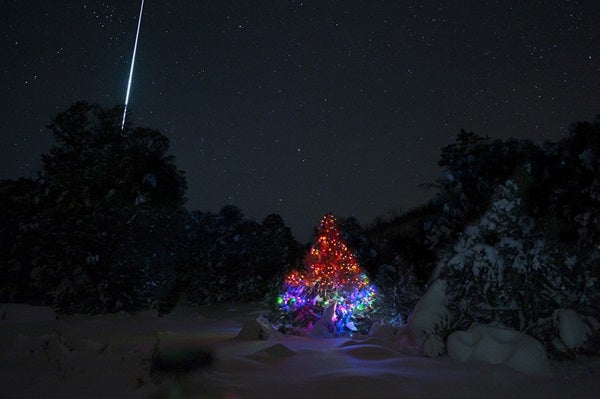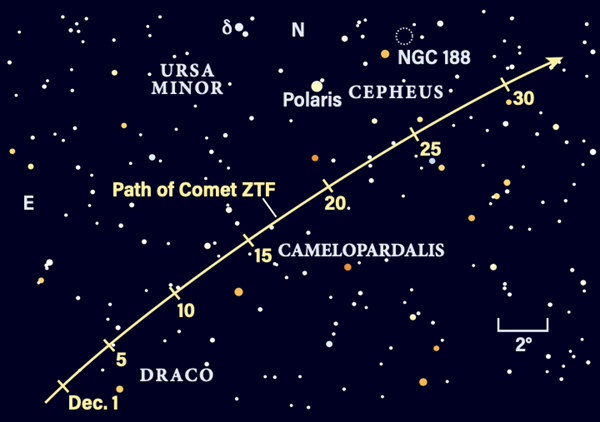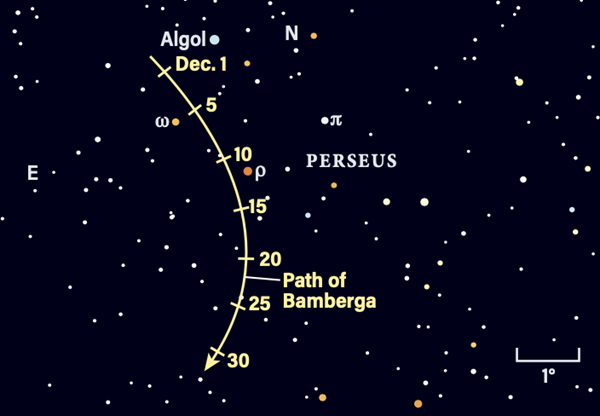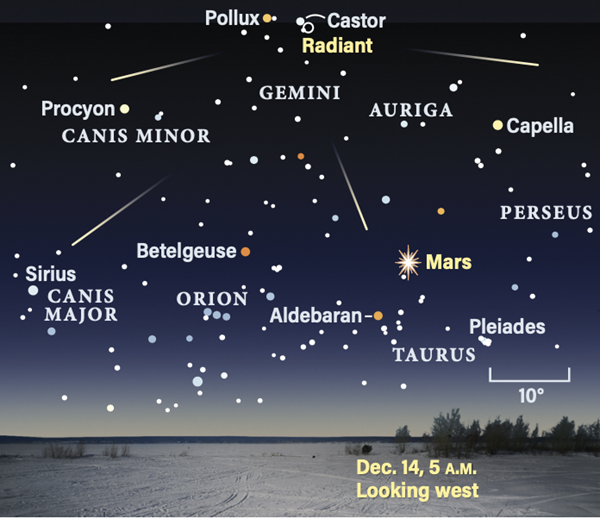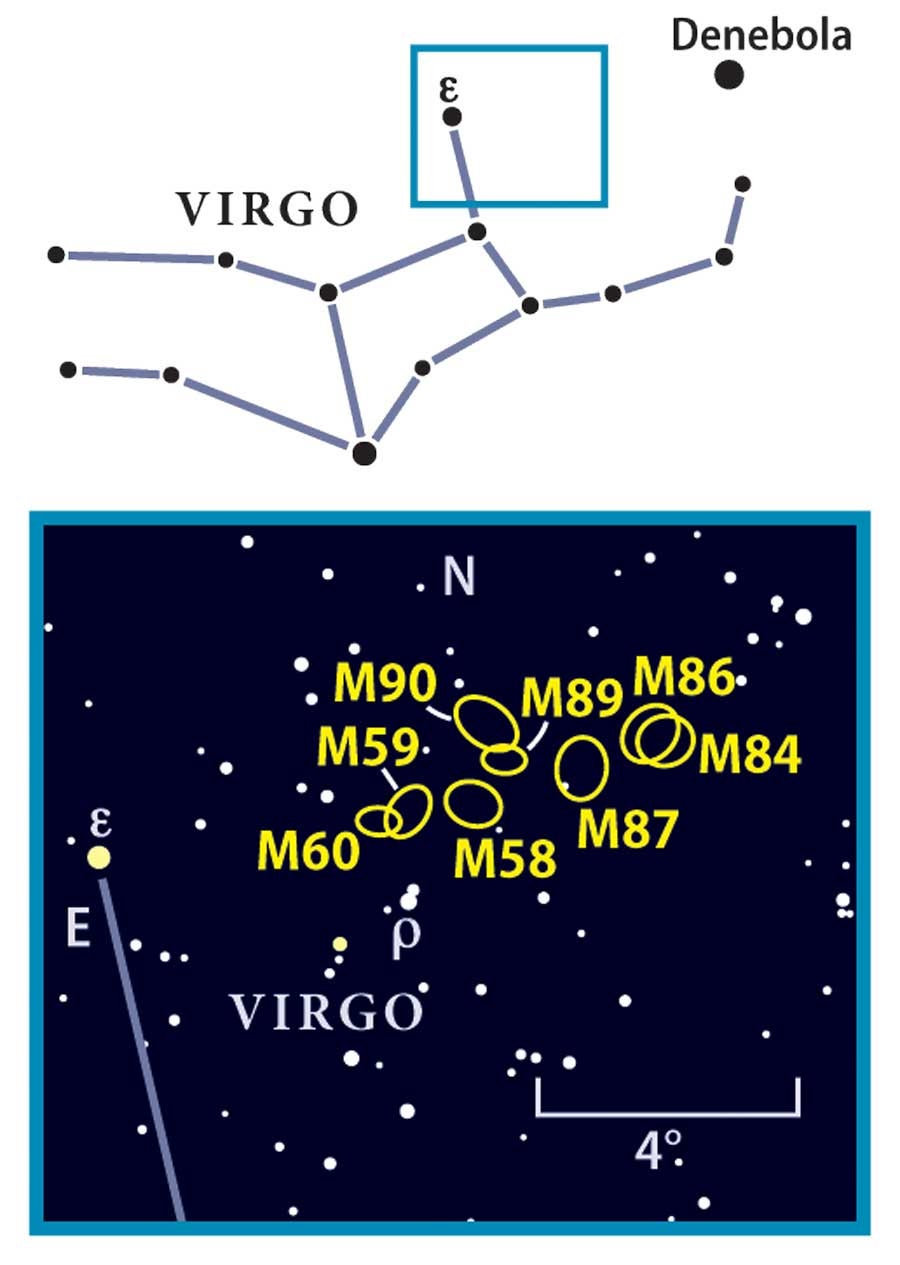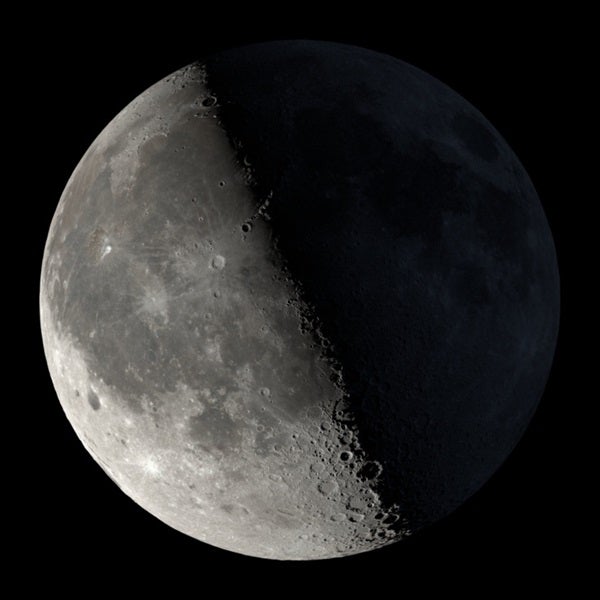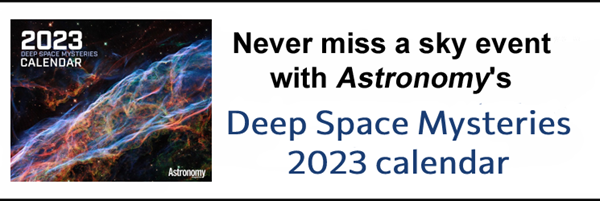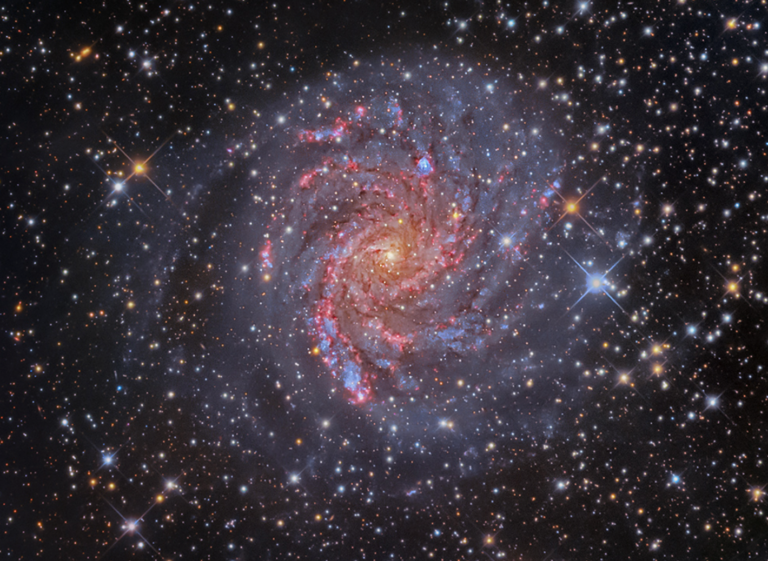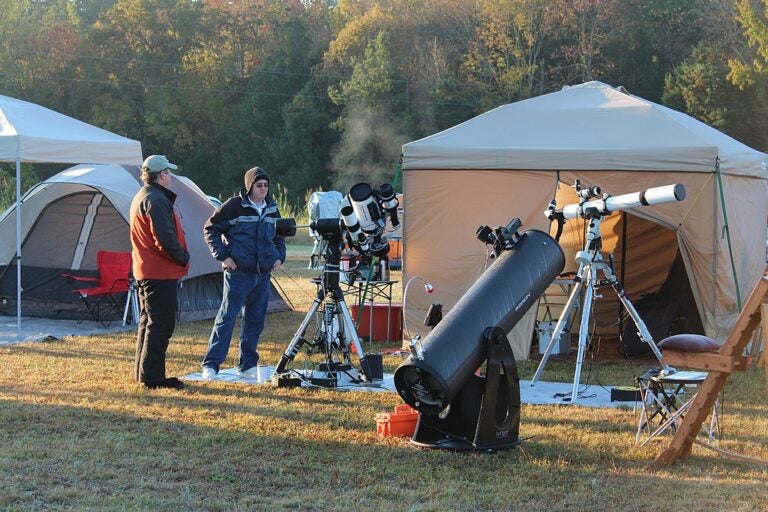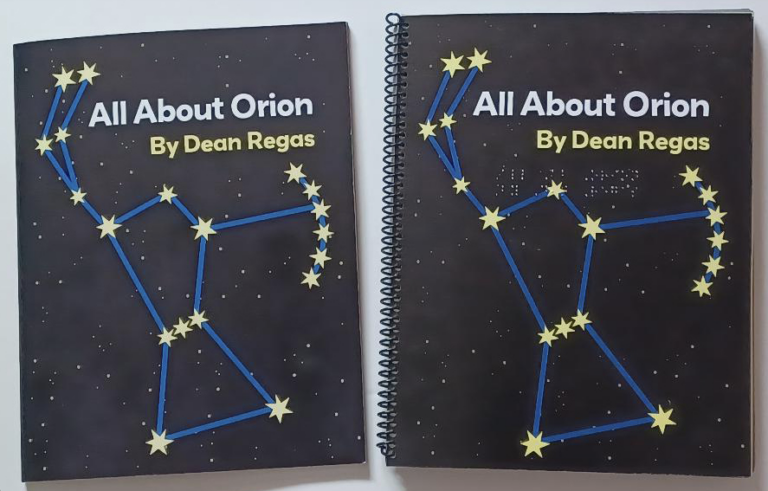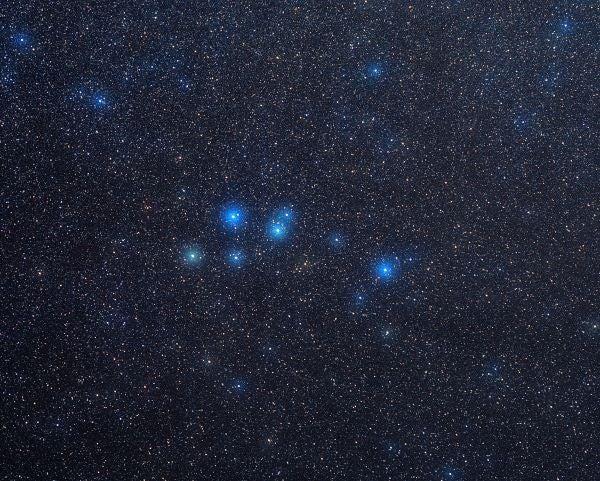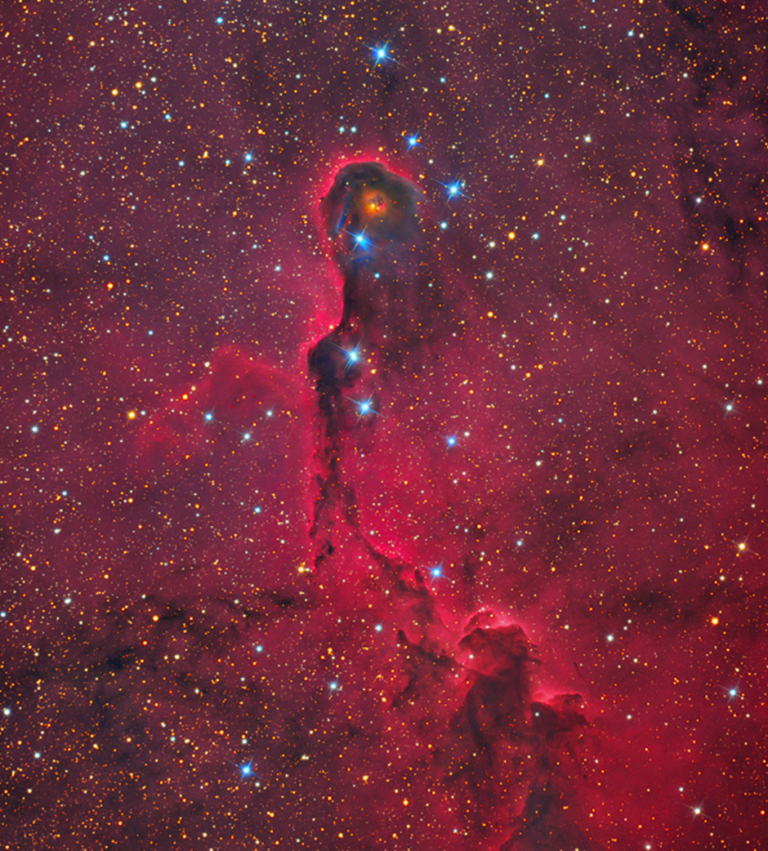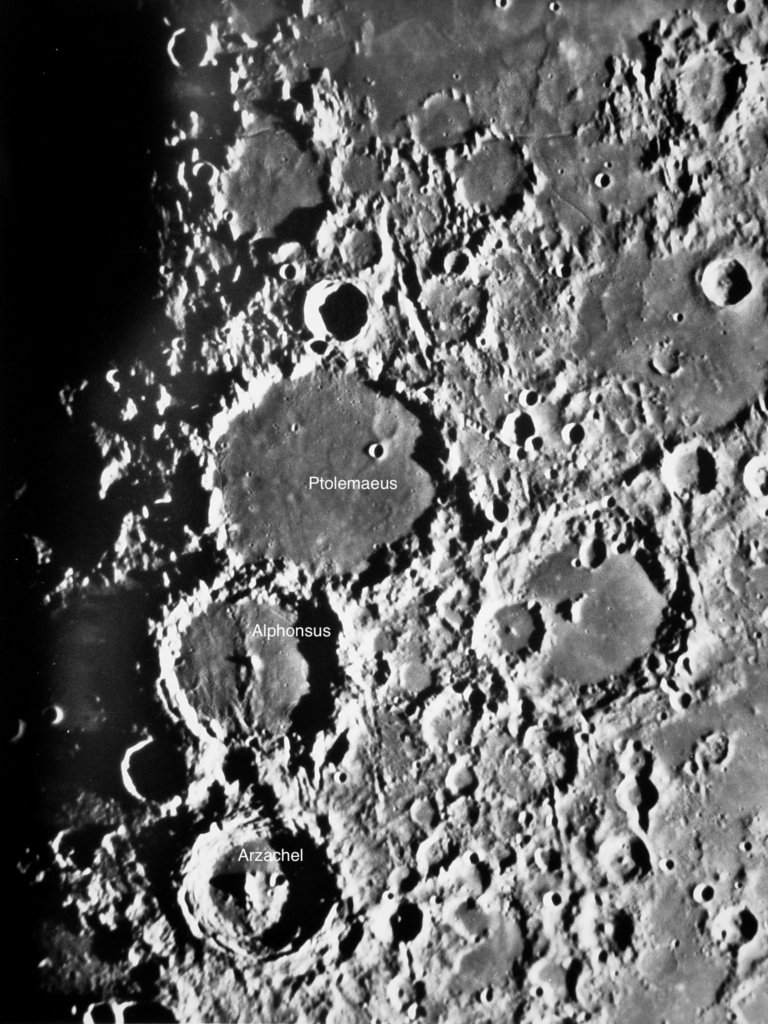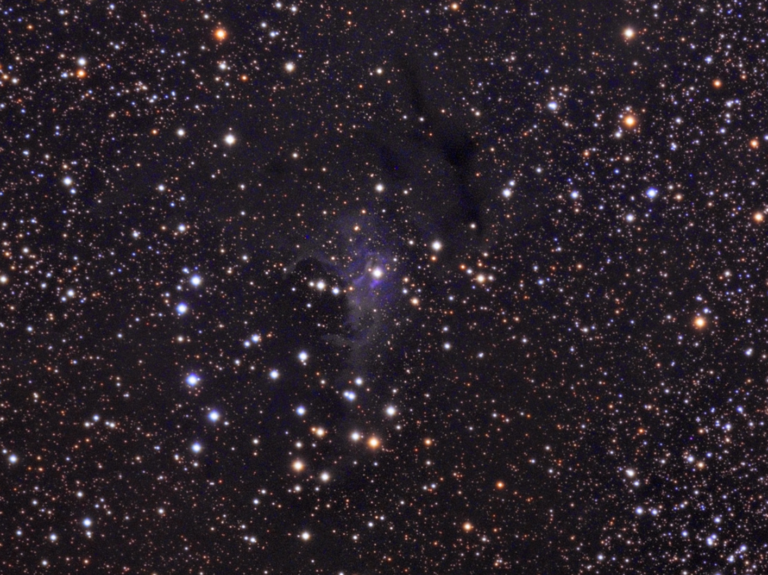Friday, December 9
Jupiter’s moons open this week with an alternating disappearing and reappearing act. Look southwest late this evening to find magnitude –2.5 Jupiter standing left (southeast) of the Circlet of Pisces. Zero in on the planet with a telescope and around 10 P.M. EST, you’ll notice only three moons are visible: Callisto to the east, and Europa (closer to the planet) and Ganymede to the west.
But keep watching. Europa is inching closer to Jupiter’s western limb. Just after 10:40 P.M. EST, Europa disappears behind the gas giant in an occultation. Not much later, shortly after 11 P.M. EST, look off to the planet’s east, where Io pops back into view as it slides out of Jupiter’s dark shadow. That shadow stretches quite far — Io will reappear some 25″ off the planet’s limb.
Also visible around this time is Jupiter’s famous Great Red Spot. Around 9 P.M. EST, it should appear roughly midway across the disk, just south of the equator. It’s moving from east to west as the planet rotates and should be visible for another two hours or so before it slides around the visible limb.
Sunrise: 7:10 A.M.
Sunset: 4:34 P.M.
Moonrise: 5:38 P.M.
Moonset: 8:44 A.M.
Moon Phase: Waning gibbous (98%)
*Times for sunrise, sunset, moonrise, and moonset are given in local time from 40° N 90° W. The Moon’s illumination is given at 12 P.M. local time from the same location.
Saturday, December 10
Saturn’s largest moon, Titan, sits due north of the planet tonight. To find it, look southwest an hour or two after sunset, where Saturn glows at magnitude 0.7 in Capricornus the Sea Goat. The planet now sits 3.5° west of Deneb Algedi.
Through a telescope, Saturn’s disk stretches 16″ across, while its rings are slightly more than double that width. Those rings are slowly getting narrower as the planet’s tilt changes with respect to our line of sight, dropping below 14° by the end of the month.
In addition to Titan directly north, Saturn is accompanied by several smaller and fainter moons. Tenth-magnitude Tethys, Dione, and Rhea sit to the planet’s west and south — Tethys is due west, Dione is southwest, and Rhea is due south. You’ll need a larger scope to pick up these moons, as they’re dimmer than magnitude 8.5 Titan. If you want to see them, opt to look earlier in the evening rather than later, as the turbulent air near the horizon will make these satellites harder to spot as the planet sinks. Saturn sets around 9:30 P.M. local time.
Sunrise: 7:11 A.M.
Sunset: 4:34 P.M.
Moonrise: 6:33 P.M.
Moonset: 9:35 A.M.
Moon Phase: Waning gibbous (94%)
Sunday, December 11
The Moon reaches apogee, the farthest point from Earth in its orbit, at 7:28 P.M. EST. It will then sit 252,195 miles (405,869 kilometers) away.
This evening is the perfect time to seek out Comet C/2020 V2 (ZTF) in Draco. Because it’s in the north, the 10th-magnitude comet is easily visible long after dark, offering good chances to enjoy its soft glow. You’ll find it tonight about 9.5° southeast of Polaris. The larger your instrument, the better, as the comet won’t be particularly bright. It will look like a faint, fuzzy patch of light compared with the pinpricks of stars through your scope. The comet is headed northwest; it will make a pass within 4° of our pole star later this month.
While you’re in the area, let’s visit the red-hued variable star VZ Camelopardalis. It lies 7.5° southeast of Polaris and shines at 5th magnitude. This older star is in the red giant phase of its life, hence its ruby color. It changes brightness slightly by about 0.1 magnitude in just less than 24 days.
Sunrise: 7:12 A.M.
Sunset: 4:35 P.M.
Moonrise: 7:33 P.M.
Moonset: 10:17 A.M.
Moon Phase: Waning gibbous (89%)
Monday, December 12
Let’s stick with the small bodies of the solar system and observe magnitude 9.7 asteroid 324 Bamberga tonight. Located in Perseus the Hero, this main-belt world is already high overhead in the east a few hours after dark. Tonight, it’s skimming past 3rd-magnitude Rho (ρ) Persei, just 17′ (less than half a degree) southeast of the star. Because it’s so close to a good signpost, you may notice the asteroid moving relative to this background star in just two or three hours. To do so, make a quick sketch or take a photo through your scope, then return every 30 to 60 minutes to recapture the scene and compare. After a few iterations, you should notice Bamberga drifting slowly southwest.
You’ll want a 4-inch scope to easily net the 140-mile-wide (225 km) asteroid. Although you may have rarely heard its name, Bamberga is one of the top 20 largest asteroids in the main belt. But it’s not always easily visible because its orbit is relatively eccentric, bringing it closer and then taking it farther from the Sun. This means that sometimes — like now — it is relatively bright, while other times, it is quite faint. By 2025, when it has moved farther from Earth and will sit out near Jupiter, it will glow barely brighter than 12th magnitude.
Sunrise: 7:13 A.M.
Sunset: 4:35 P.M.
Moonrise: 8:34 P.M.
Moonset: 10:52 A.M.
Moon Phase: Waning gibbous (82%)
Tuesday, December 13
The distant ice giant Uranus stands 1° due north of Sigma (σ) Arietis tonight, offering an excellent view. Both will fit into the field of view of 7×50 binoculars or any low-power telescope.
An hour after sunset, Uranus is 35° high in the east. Aries sits just west of Taurus, where brilliant magnitude –1.9 Mars still dominates. The Red Planet is now nearly 9° north (to the upper left) of the red giant Aldebaran. From Mars, skim about 28.5° west, and you’ll land on Uranus. The Pleiades star cluster sits about halfway between the two planets, slightly above an east-west line connecting them.
The longer you wait to view the scene, the better, as the sky will grow darker and Taurus and Aries will rise even higher. Though a telescope, Uranus will span 4″ — its grayish-blue disk will appear as a small, “flat” star compared to the true suns around it. It sits a little less than halfway between magnitude 5.5 Sigma (to the planet’s south) and magnitude 5.3 Pi (π) Arietis (to the planet’s north).
Sunrise: 7:13 A.M.
Sunset: 4:35 P.M.
Moonrise: 9:36 P.M.
Moonset: 11:22 A.M.
Moon Phase: Waning gibbous (74%)
Wednesday, December 14
Today marks the peak of the annual Geminid meteor shower. The shower’s radiant is located in — you guessed it — Gemini, about 1.5° west (to the lower right) of blue-white, magnitude 1.6 Castor. A little under 4.5° to Castor’s left (southwest) is Pollux, a slightly cooler (yellower) but slightly brighter (magnitude 1.2) star.
The best time to look for Geminid meteors is in the morning, a few hours before sunrise. Glancing slightly away from the radiant will net meteors with longer trains. But there’s one catch this year: The bright Moon isn’t far away in Leo, obscuring most of the fainter meteors streaking across the sky. Nonetheless, it’s worth trying to spot a few brighter shower members, as the peak rate could be as high as 150 per hour. Plus, the shower will last through the 17th, giving the Moon a few more days to move farther east and slim down a bit.
December hosts not one, but two meteor showers — prospects for the Ursids later this month are much better, although that shower’s expected rate is lower. Stay tuned!
Sunrise: 7:14 A.M.
Sunset: 4:35 P.M.
Moonrise: 10:37 P.M.
Moonset: 11:48 A.M.
Moon Phase: Waning gibbous (66%)
Thursday, December 15
If you’re still in early-morning observing mode to catch a few stray Geminids, look east this morning to enjoy the large constellation Virgo, which dominates the sky in the southeast. Right off the bat, you’ll likely notice the Maiden’s brightest star, 1st-magnitude Spica. But we’re in search of extragalactic targets, so grab your small scope and let’s go!
The dense Virgo Cluster of galaxies sits in this region of the sky, with several Messier galaxies crammed into a small space near 3rd-magnitude Vindemiatrix (Epsilon [ϵ] Virginis) in the constellation’s northern regions. From Epsilon, look some 7.7° west-northwest to land smack dab on one of the most famous galaxies: M87. This mighty elliptical hosts a supermassive black hole weighing billions of solar masses; it was also the first supermassive black hole imaged by the Event Horizon Telescope in 2019. M87 should look like a slightly oblong, faint, fuzzy glow, not entirely unlike the comet we viewed earlier this week.
But it’s not alone — through a low-power eyepiece, you may notice several of its neighbors, including M84 and M86 roughly 1° to the northwest, and M89 and M90 about 1° northeast. M58 lies just less than 2° to the east-southeast. There are several other galaxies in this region as well — check out the chart to the right and read through Astronomy columnist Glenn Chaple’s tips for exploring the Virgo Cluster to get the most out of the view.
Sunrise: 7:15 A.M.
Sunset: 4:35 P.M.
Moonrise: 11:39 P.M.
Moonset: 12:11 P.M.
Moon Phase: Waning gibbous (56%)
Friday, December 16
Last Quarter Moon occurs at 3:56 A.M. EST. During this phase, Luna lingers in the morning sky, affording wonderful views in the early twilight. Now in western Virgo (remember where we looked yesterday morning?), the Moon’s face appears divided in half by the terminator, which separates night from day on the lunar surface.
Illuminated is the western portion of our satellite (east on the sky), which includes features such as the bright craters Copernicus, Aristarchus, and Kepler, as well as the dark oval crater Grimaldi. Also prominent are the large, dark Sea of Rains and Ocean of Storms.
For the greatest contrast of light and dark, though, explore with a telescope just along the terminator slicing through the middle of the Moon. Watch how the dynamic lighting changes over just a few hours here, transforming the look of the craters in along the day-night line before your very eyes.
Sunrise: 7:16 A.M.
Sunset: 4:36 P.M.
Moonrise: —
Moonset: 12:33 P.M.
Moon Phase: Waning crescent (46%)

